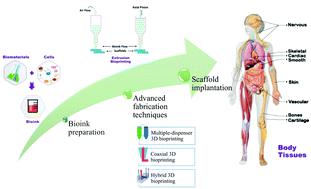当前位置:
X-MOL 学术
›
Biomater. Sci.
›
论文详情
Our official English website, www.x-mol.net, welcomes your
feedback! (Note: you will need to create a separate account there.)
Recent progress in extrusion 3D bioprinting of hydrogel biomaterials for tissue regeneration: a comprehensive review with focus on advanced fabrication techniques
Biomaterials Science ( IF 5.8 ) Pub Date : 2020-10-09 , DOI: 10.1039/d0bm00973c Mohsen Askari 1, 2, 3, 4, 5 , Moqaddaseh Afzali Naniz 1, 2, 3, 4, 5 , Monireh Kouhi 6, 7, 8, 9, 10 , Azadeh Saberi 10, 11, 12, 13 , Ali Zolfagharian 14, 15, 16, 17 , Mahdi Bodaghi 1, 2, 3, 4, 5
Biomaterials Science ( IF 5.8 ) Pub Date : 2020-10-09 , DOI: 10.1039/d0bm00973c Mohsen Askari 1, 2, 3, 4, 5 , Moqaddaseh Afzali Naniz 1, 2, 3, 4, 5 , Monireh Kouhi 6, 7, 8, 9, 10 , Azadeh Saberi 10, 11, 12, 13 , Ali Zolfagharian 14, 15, 16, 17 , Mahdi Bodaghi 1, 2, 3, 4, 5
Affiliation

|
Over the last decade, 3D bioprinting has received immense attention from research communities for developing functional tissues. Thanks to the complexity of tissues, various bioprinting methods have been exploited to figure out the challenges of tissue fabrication, in which hydrogels are widely adopted as a bioink in cell printing technologies based on the extrusion principle. Thus far, there is a wealth of literature proposing the crucial parameters of extrusion-based bioprinting of hydrogel biomaterials (e.g., hydrogel properties, printing conditions, and tissue scaffold design) toward enhancing performance. Despite the growing research in this field, numerous challenges that hinder advanced applications still exist. Herein, the most recently reported hydrogel-based bioprinted scaffolds, i.e., skin, bone, cartilage, vascular, neural, and muscular (including skeletal, cardiac, and smooth) scaffolds, are systematically discussed with an emphasis on the advanced fabrication techniques from the tissue engineering perspective. The methods covered include multiple-dispenser, coaxial, and hybrid 3D bioprinting. The present work is a unique study to figure out the opportunities of the novel techniques to fabricate complicated constructs with structural and functional heterogeneity. Finally, the principal challenges of current studies and a vision of future research are presented.
中文翻译:

用于组织再生的水凝胶生物材料挤压3D生物打印的最新进展:以先进的制造技术为重点的全面综述
在过去的十年中,3D生物打印在研究功能组织方面受到了研究界的极大关注。由于组织的复杂性,已开发出各种生物印刷方法来解决组织制造的挑战,其中基于挤出原理,水凝胶被广泛用作细胞印刷技术中的生物墨水。迄今为止,有大量文献提出了基于挤压的水凝胶生物材料生物打印的关键参数(例如,水凝胶特性,打印条件和组织支架设计),以提高性能。尽管该领域的研究不断增长,但仍然存在许多阻碍高级应用程序的挑战。本文中,最近报道的基于水凝胶的生物打印支架,即从组织工程的角度,系统地讨论了皮肤,骨骼,软骨,血管,神经和肌肉(包括骨骼,心脏和平滑)支架,并着重于先进的制造技术。涵盖的方法包括多分配器,同轴和混合3D生物打印。本工作是一项独特的研究,旨在弄清新技术制造具有结构和功能异质性的复杂结构的机会。最后,介绍了当前研究的主要挑战和对未来研究的展望。
更新日期:2020-11-13
中文翻译:

用于组织再生的水凝胶生物材料挤压3D生物打印的最新进展:以先进的制造技术为重点的全面综述
在过去的十年中,3D生物打印在研究功能组织方面受到了研究界的极大关注。由于组织的复杂性,已开发出各种生物印刷方法来解决组织制造的挑战,其中基于挤出原理,水凝胶被广泛用作细胞印刷技术中的生物墨水。迄今为止,有大量文献提出了基于挤压的水凝胶生物材料生物打印的关键参数(例如,水凝胶特性,打印条件和组织支架设计),以提高性能。尽管该领域的研究不断增长,但仍然存在许多阻碍高级应用程序的挑战。本文中,最近报道的基于水凝胶的生物打印支架,即从组织工程的角度,系统地讨论了皮肤,骨骼,软骨,血管,神经和肌肉(包括骨骼,心脏和平滑)支架,并着重于先进的制造技术。涵盖的方法包括多分配器,同轴和混合3D生物打印。本工作是一项独特的研究,旨在弄清新技术制造具有结构和功能异质性的复杂结构的机会。最后,介绍了当前研究的主要挑战和对未来研究的展望。











































 京公网安备 11010802027423号
京公网安备 11010802027423号